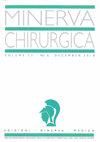微创甲状腺切除术和术中神经监测(IONM): 215例连续病例的单一大容量中心经验。
IF 1.3
Q3 Medicine
引用次数: 2
摘要
背景内分泌手术最近的发展特点是引入了微创视频辅助技术。当一项新技术被引入外科手术时,不良事件的发生率必须与以前的标准化技术相同。在MIVAT手术中,并发症发生率,尤其是神经损伤风险与外科医生的经验有关。新方法是在MIVAT中使用术中神经监测(IONM),以降低技术难度更大的手术中喉神经损伤率。方法我们分析了2014年9月至2019年12月在一个大容量手术中心接受MIVAT技术和同时使用IONM治疗的215名患者的临床和手术数据。我们记录了有关年龄、性别、术前诊断、手术时间、术后早期低钙血症、血肿和声带麻痹的数据。我们将这些数据与学习曲线开始时的前211例MIVAT病例(2005年7月至2009年6月)进行了比较,这些病例在不使用IONM的情况下进行。我们试图强调MIVAT和IONM同时使用对手术结果的影响,并将结果与我们之前的研究进行比较,同时强调勒宁曲线效应。结果14例(6.5%)患者术后出现暂时性临床低钙血症。无术后血肿记录。在甲状腺切除术中使用I-IONM,我们记录了5例信号丢失;在3例(1.4%)中,我们经历了术后暂时性声带麻痹,只有1例是最终性麻痹。我们没有强调前211例和后215例手术并发症发生率的统计差异。我们还没有发现与在没有IONM的情况下进行的MIVAT相关的MIVAT程序中使用IONM的统计显著差异。在我们以前的MIVAT系列病例中,报告的短暂性神经麻痹的百分比为2,4%(p=ns)。手术适应症发生了变化。结论根据我们的经验,我们报告在MIVAT中使用IONM同样有助于提高手术的安全性。与MIVAT相关的文献中神经麻痹的风险与经典技术(CT)的相关风险相同。我们还没有发现在MIVAT中使用IONM与没有IONM的MIVAT相关的统计积极性。在我们以前的MIVAT系列病例中,报告的短暂性神经麻痹的百分比为2,4%(p=ns)。在我们看来,最重要的IONM效应是外科医生在更具挑战性的手术中使用IONM所体验到的“安全感”。作为一家培训外科住院医师的大学医院,我们还认为IONM是一种非常有用的教学支持。本文章由计算机程序翻译,如有差异,请以英文原文为准。
Mini-invasive thyroidectomy and Intraoperative Neuromonitoring (IONM): a single high-volume center experience in 215 consecutive cases.
BACKGROUND
Endocrine surgery recent evolution has been characterized by introduction of mini-invasive video-assisted technique. When a new technique is introduced in surgical use the rate of adverse events must be the same of previous standardized technique. In MIVAT procedure complication rate and in particular nerve injury risk is associated surgeon's experience. The new approach is the intraoperative neuro-monitoring (IONM) use in MIVAT in order to reduce the laryngeal nerve injury rate in a more technically difficult surgical procedure.
METHODS
We analyzed clinical and surgical data regarding 215 patients treated with MIVAT technique and simultaneous IONM utilization from September 2014 to December 2019 in a single high-volume surgical center. We recorded data regarding age, gender, preoperative diagnosis, surgical time, early postoperative hypocalcemia, hematoma and vocal cord palsy. We compared these data to our first 211 cases of MIVAT (July 2005 -June 2009) at the beginning of the learning curve, performed without using IONM. We tried to highlight the impact of MIVAT and IONM simultaneous use on surgical outcome comparing results to our previous studies, also highlighting the lerning curve effect.
RESULTS
We detected a postoperative transitory clinical hypocalcemia in 14 pts (6,5%). No postoperative hematoma was recorded. Using I-IONM during thyroidectomy, we recorded in 5 cases a loss of signal; in 3 cases (1,4%) we experienced a temporary postoperative vocal cord palsy, only 1 case of definitive palsy. We didn't highlight statistical differences in surgical complications rate between the first 211 cases and these last 215 cases. We haven't identify a statistical significative difference regarding IONM use during MIVAT procedure related to MIVAT performed without IONM. In our previous experience cases series of MIVAT the percentage of transitory nerve palsy reported was 2,4% (p=ns). Surgical indication has changed.
CONCLUSIONS
In our experience we report that the use of IONM in MIVAT is as helpful to improve the safe of procedure. The risk of nerve palsy in literature associated to MIVAT is the same of the related one to classic technique (CT). We haven't identify a statistical positivity to use IONM in MIVAT related to MIVAT without IONM. In our previous experience cases series of MIVAT the percentage of transitory nerve palsy reported was 2,4% (p=ns). The most important IONM effect, in our opinion is the "safety feeling" experienced by the surgeon using IONM in a more challenging procedure. As a University Hospital, training surgery residents, we also identified the IONM as a very useful teaching support.
求助全文
通过发布文献求助,成功后即可免费获取论文全文。
去求助
来源期刊

Minerva chirurgica
医学-外科
CiteScore
1.40
自引率
0.00%
发文量
0
审稿时长
>12 weeks
期刊介绍:
Minerva Chirurgica publishes scientific papers on surgery. Manuscripts may be submitted in the form of editorials, original articles, review articles, case reports, special articles, letters to the Editor and guidelines. The journal aims to provide its readers with papers of the highest quality and impact through a process of careful peer review and editorial work.
 求助内容:
求助内容: 应助结果提醒方式:
应助结果提醒方式:


